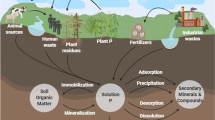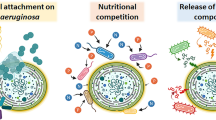Abstract
The objective of this study was to understand the effect of pH and ionic strength of aluminum sulfate on the flocculation of microalgae. It was found that changing pH and ionic strength influenced algal flocculation by changing the zeta potential of cells, which was described by the classical theory of Derjaguin, Landau, Verwey, and Overbeek (DLVO). For both algal species of Scenedesmus dimorphus and Nannochloropsis oculata, cells with lower total DLVO interaction energy had higher flocculation efficiency, indicating that the DLVO model was qualitatively accurate in predicting the flocculation of the two algae. However, the two algae responded differently to changing pH and ionic strength. The flocculation of N. oculata increased with increasing aluminum sulfate concentration and favored either low (pH 5) or high (pH 10) pH where cells had relatively low negative surface charges. For S. dimorphus, the highest flocculation was achieved at low ionic strength (1 μM) or moderate pH (pH 7.5) where cell surface charges were fully neutralized (zero zeta potential).






Similar content being viewed by others
References
Brennan, L., & Owende, P. (2010). Biofuels from microalgae—a review of technologies for production, processing, and extractions of biofuels and co-products. Renewable and Sustainable Energy Reviews, 14(2), 557–577.
Mata, T. M., Martins, A. A., & Caetano, N. S. (2010). Microalgae for biodiesel production and other applications: a review. Renewable and Sustainable Energy Reviews, 14(1), 217–232.
Pienkos, P. T., & Darzins, A. (2009). The promise and challenges of microalgal derived biofuels. Biofuels, Bioproducts and Biorefining, 3(4), 431–440.
Yuan, W., Shen, Y., Pei, Z. J., Wu, Q., & Mao, E. (2009). Microalgae mass production methods. Transactions of the ASABE, 52(4), 1275–1287.
Gudin, C., & Therpenier, C. (1986). Bioconversion of solar energy into organic chemicals by microalgae. Biotechnology Advances, 6, 73–110.
Uduman, N., Qi, Y., Danquah, M. K., Forde, G. M., Hoadley, A. (2010). Dewatering of microalgal cultures: a major bottleneck to algae-based fuels. Journal of Renewable Sustainable Energy, 012701.
Lubián, L. M. (1989). Concentrating cultured marine microalgae with chitosan. Aquacultural Engineering, 8(4), 257–265.
Morales, J., De La Noüe, J., & Picard, G. (1985). Harvesting marine microalgae species by chitosan flocculation. Aquacultural Engineering, 4(4), 257–270.
Molina Grima, E., Belarbi, E. H., Acien Fernandez, F. G., Robles Medina, A., & Chisti, Y. (2003). Recovery of microalgal biomass and metabolites: process options and economics. Biotechnology Advances, 20(7), 491–515.
Ives, K. J. (1959). The significance of surface electric charge on algae in water purification. Journal of Biochemical and Microbiological Technology and Engineering, 1(1), 37–47.
Tenney, M. W., & Stumm, W. (1965). Chemical flocculation of microorganisms in biological waste treatment. Journal of the Water Pollution Control Federation, 37, 1370–1388.
Knuckey, R. M., Brown, M. R., Robert, R., & Frampton, D. M. (2006). Production of microalgal concentrates by flocculation and their assessment as aquaculture feeds. Aquacultural Engineering, 35(3), 300–313.
Eldridge, R. J., Hill, D. R., & Gladman, B. R. (2012). A comparative study of the coagulation behaviour of marine microalgae. Journal of Applied Phycology, 24(6), 1667–1679.
Valdés Barceló, F. J., Hernández Férez, M. D. R., Gómez Siurana, A., Marcilla Gomis, A., Chápuli Fernández, E. (2008). Study of the efficiency of different flocculants for effective microalgae harvesting. Presentation at the 11th Mediterranean Congress of Chemical Engineering, Barcelona 2008.
Jiang, J. Q., Graham, N. J., & Harward, C. (1993). Comparison of polyferric sulphate with other coagulants for the removal of algae and algae-derived organic matter. Water Science and Technology, 27(11), 221–230.
Golueke, C. G., & Oswald, W. J. (1965). Harvesting and processing sewage-grown planktonic algae. Journal of the Water Pollution Control Federation, 37(4), 471–498.
Verwey, E. J. W., & Overbeek, J. T. G. (1941). Theory of the stability of lyophobic colloids. Dover Publications, 1999.
Derjaguin, B. V., & Lanadau, L. (1941). Theory of the stability of strongly charged lyophobic sols and of the adhesion of strongly charged particles in solution of electrolytes. Acta Physiochimica USSR, 14, 633.
Marshall, K. C., Stout, R., & Mitchell, R. (1971). Mechanism of the initial events in the sorption of marine bacteria to surfaces. Journal of General Microbiology, 68(3), 337–348.
Facchini, P. J., Neumann, A. W., & DiCosmo, F. (1989). Adhesion of suspension-cultured Catharanthus roseus cells to surfaces: effect of pH, ionic strength, and cation valency. Biomaterials, 10(5), 318–324.
Fletcher, M., Lessmann, J. M., & Loeb, G. I. (1991). Bacterial surface adhesives and biofilm matrix polymers of marine and freshwater bacteria. Biofouling, 4(1–3), 129–140.
Zita, A., & Hermansson, M. (1994). Effects of ionic strength on bacterial adhesion and stability of flocs in a wastewater activated sludge system. Applied and Environmental Microbiology, 60(9), 3041–3048.
Liu, X. M., Sheng, G. P., & Yu, H. Q. (2007). DLVO approach to the flocculability of a photosynthetic H2-producing bacterium, Rhodopseudomonas acidophila. Environmental Science & Technology, 41(13), 4620–4625.
Van Loosdrecht, M. C., Lyklema, J., Norde, W., Schraa, G., & Zehnder, A. J. (1987). Electrophoretic mobility and hydrophobicity as a measured to predict the initial steps of bacterial adhesion. Applied and Environmental Microbiology, 53(8), 1898–1901.
Norde, W., & Lyklema, J. (1989). Protein adsorption and bacterial adhesion to solid surfaces: a colloid-chemical approach. Colloids and Surfaces, 38(1), 1–13.
Roper, M. M., & Marshall, K. C. (1974). Modification of the interaction between Escherichia coli and bacteriophage in saline sediment. Microbial Ecology, 1(1), 1–13.
Tatulian, S. A., Gordeliy, V. I., Sokolova, A. E., & Syrykh, A. G. (1991). A neutron diffraction study of the influence of ions on phospholipid membrane interactions. Biochimica et Biophysica Acta (BBA)-Biomembranes, 1070(1), 143–151.
Tenney, M. W., Echelberger, W. F., Schuessler, R. G., & Pavoni, J. L. (1969). Algal flocculation with synthetic organic polyelectrolytes. Applied Microbiology, 18(6), 965–971.
Shen, Y., Ty, M., Pei, Z. J., Yuan, W. (2010). The effect of growth medium on biomass and lipid yield of microalgae Nannochloropsis. Mid-Central Conference of ASABE 2010.
Sorokin, C., & Krauss, R. W. (1958). The effect of light intensity on the growth rates of green algae. Plant Physiology, 33, 109–113.
Hermansson, M. (1999). The DLVO theory in microbial adhesion. Colloids and Surfaces B: Biointerfaces, 14(1), 105–119.
Zhu, C. J., & Lee, Y. K. (1997). Determination of biomass dry weight of marine microalgae. Journal of Applied Phycology, 9(2), 189–194.
Gregory, J., & Duan, J. (2001). Hydrolyzing metal salts as coagulants. Pure and Applied Chemistry, 73(12), 2017–2026.
Hadjoudja, S., Deluchat, V., & Baudu, M. (2010). Cell surface characterisation of Microcystis aeruginosa and Chlorella vulgaris. Journal of Colloid and Interface Science, 342(2), 293–299.
Shen, Y., Cui, Y., & Yuan, W. (2013). Flocculation optimization of microalga Nannochloropsis oculata. Applied Biochemistry and Biotechnology, 169(7), 2049–2063.
Acknowledgments
The authors thank Dr. Albena Ivanisevic at the Department of Material Science and Engineering at NCSU for the use of the Zetasizer and Alexander Richter at the Department of Chemical and Biomolecular Engineering of NCSU for the kind help in zeta potential measurements. This research was financially supported by the US National Science Foundation (Award # CMMI-1239078) and the startup fund of North Carolina State University.
Author information
Authors and Affiliations
Corresponding author
Rights and permissions
About this article
Cite this article
Cui, Y., Yuan, W. & Cheng, J. Understanding pH and Ionic Strength Effects on Aluminum Sulfate-Induced Microalgae Flocculation. Appl Biochem Biotechnol 173, 1692–1702 (2014). https://doi.org/10.1007/s12010-014-0957-4
Received:
Accepted:
Published:
Issue Date:
DOI: https://doi.org/10.1007/s12010-014-0957-4




